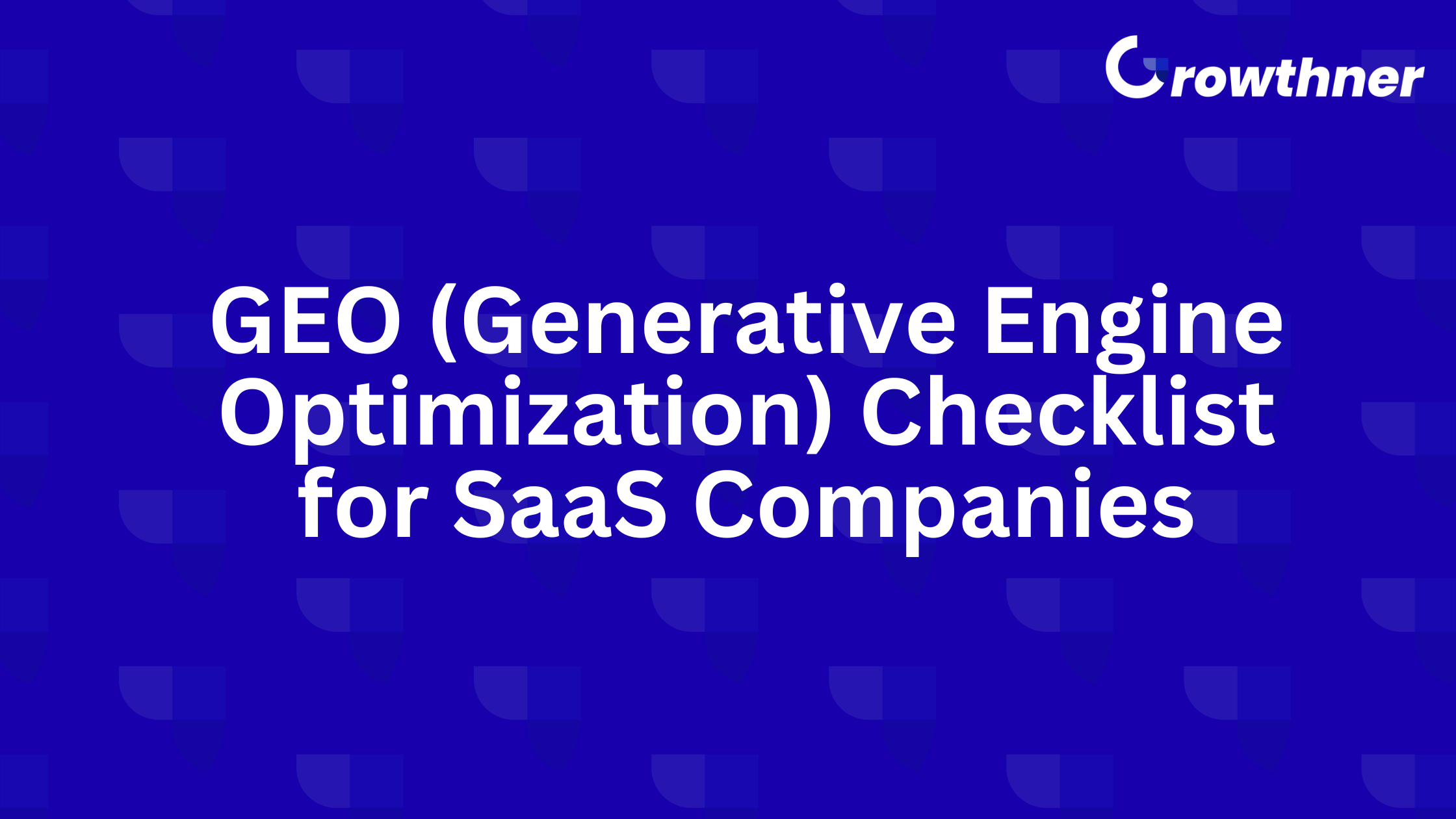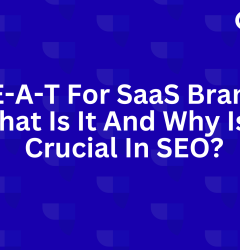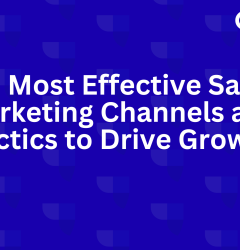05 Sep

Published by: Amit Kakkar
Published on: September 5, 2025
Last updated on: November 8, 2025
Last Updated on November 8, 2025 by admin
Imagine this. A potential buyer types into ChatGPT :
“What’s the best SaaS onboarding tool for startups?”
Within seconds, the AI lists three products.
Your tool isn’t one of them.
That moment matters. You didn’t lose a Google ranking. You lost a buyer’s trust before they even landed on your site.
This is the reality of today’s search. Generative engines like ChatGPT, Perplexity, and Google’s AI Overviews are becoming the first stop for SaaS buyers. They don’t just show links. They decide which brands deserve a mention.
For SaaS companies, this shift creates both risk and opportunity. If your brand isn’t cited in these AI-driven results, you’re invisible to a growing segment of buyers. But if you are cited, you gain credibility and attention at the exact moment of intent.
That’s where Generative Engine Optimization (GEO) comes in.
In this article, we’ll walk through a step-by-step GEO checklist for SaaS companies. It’s designed to help you build entity authority, increase your chances of being cited by LLMs, and future-proof your visibility in an AI-first search landscape.
What is GEO?
Generative Engine Optimization (GEO) is the process of optimizing your content so it appears in responses generated by AI-powered search engines like ChatGPT, Gemini, Perplexity, and Bing Copilot. Unlike traditional SEO, which focuses on ranking web pages in Google’s search results, GEO is about ensuring that your SaaS brand is cited, referenced, and recommended within AI-generated answers.
Here’s how GEO is different from SEO :
- Search vs. Answers – Traditional SEO aims for page-one rankings. GEO focuses on being included in AI summaries, recommendations, and conversational outputs.
- Keywords vs. Natural Language – SEO relies on keyword targeting. GEO prioritizes context-rich, conversational content that aligns with how users phrase questions to AI.
- Clicks vs. Citations – SEO drives clicks through links. GEO ensures your brand is mentioned, trusted, and cited by generative engines, even if users don’t click through immediately.
For SaaS companies, GEO matters because buyers increasingly use AI tools to :
- Compare software solutions.
- Get quick answers to “best tool for X” type queries.
- Research product features, pricing, and use cases.
If your content isn’t optimized for AI discovery, your SaaS risks being left out of the conversation—even if you rank well on Google.
Why SaaS Companies Can’t Ignore GEO?
SaaS buyers rely on quick, trustworthy answers. They ask ChatGPT which CRM integrates best with Slack, or Perplexity for the “top SaaS onboarding platforms.” If your product isn’t mentioned in those answers, you’ve lost visibility at a critical moment of consideration.
Here’s what’s at stake :
- Declining clicks from Google SERPs : AI Overviews reduce traditional organic clicks.
- Citations drive authority : Being cited in an LLM output is the new version of ranking top 3 in Google.
- Pipeline impact : For SaaS, missing citations means fewer trials, demos, and SQLs.
Example : A SaaS company offering video hosting might rank well in Google today, but if Loom or Vimeo dominate AI answers tomorrow, that visibility disappears. GEO ensures your brand stays discoverable.
Understanding GEO in the SaaS Context
What is GEO?
Generative Engine Optimization (GEO) is the practice of optimizing your brand, content, and digital footprint so that large language models (LLMs) and AI-powered search engines cite you as a trusted source.
SEO vs GEO
- SEO is about optimizing for ranking on Google’s blue links.
- GEO is about optimizing for entity recognition, trust signals, and structured context so AI engines pull you into their generated answers.
For SaaS companies, GEO is particularly relevant because :
- Buyers research tools across multiple touchpoints (Google, G2, Reddit, ChatGPT).
- Generative engines synthesize from many sources, not just SERPs.
The more your brand is mentioned and structured online, the higher the chance AI “knows” and cites you.
Case in point : Notion became dominant in AI answers because it’s heavily mentioned in product roundups, user forums, and review sites. Smaller SaaS tools without this breadth of mentions are often left out.
Looking for an SEO agency that can help with LLM optimization? Check out the best LLM optimization agencies for your SaaS brand.
The GEO Checklist for SaaS Companies
Here’s the framework SaaS marketers can implement today.
1. Nail Down Entity and Brand Optimization
LLMs don’t see your website the way Google does. They see entities and relationships. To be cited, your SaaS needs to be a recognizable entity.
Checklist :
- Ensure brand consistency across Crunchbase, Wikipedia, LinkedIn, and directories.
- Publish press releases and thought-leadership guest posts to expand entity connections.
- Prioritize brand mentions even without backlinks.
- Use schema (Organization, Product) to signal entity attributes.
Step-by-step example :
- Create a Crunchbase profile with accurate funding and leadership info.
- Add your SaaS to G2 and Capterra, ensuring descriptions are keyword-rich.
- Secure a Wikipedia mention if your brand has enough credibility.
- Standardize “About Us” copy across every platform.
This is how SaaS brands like HubSpot became “default” entities in marketing discussions.
2. Build a Semantic Topical Map
Generative engines prefer structured, interconnected knowledge. A random collection of blogs won’t cut it.
Steps :
- Identify your central entity (for example, “SaaS project management software”).
- Create pillar content like “The Complete Guide to Project Management SaaS.”
- Build supporting blogs: integrations, pricing comparisons, industry-specific use cases.
- Interlink them to form a semantic network.
Example :
ClickUp’s content strategy isn’t just about blogs. They cover productivity, integrations, templates, and workflows in a structured ecosystem. This makes them a top citation in AI-generated answers on productivity software.
3. Optimize for AI-Friendly Content Structures
AI engines rely heavily on structured text.
Best practices :
- Use questions as subheadings (H2/H3).
- Add tables (pricing comparison), lists (onboarding checklist), and Q&A.
- Create “What is” sections with concise definitions.
- Add structured FAQs with schema.
Mini-example :
If you run a SaaS CRM, instead of writing “Why Integrations Matter,” add a table comparing integrations :
- HubSpot → Gmail, Slack, Zapier
- Zoho CRM → LinkedIn, Microsoft Teams
That’s the type of structured info LLMs lift.
4. Leverage Structured Data and Metadata
Action items :
- Add Article schema for blogs, Product schema for SaaS features, and FAQ schema.
- Write metadata naturally, answering “what the user is asking.”
- Use descriptive image names like saas-onboarding-checklist.png.
- Test schema with Google’s Rich Results tool.
Why it matters : Structured data increases machine readability. When Perplexity or Gemini scrape your content, they rely on these cues to extract correct answers.
5. Authority Through Brand Mentions and Citations
GEO favors brands that are widely referenced.
Strategies :
- Run PR campaigns with data-led stories.
- Get featured in SaaS “best of” roundups.
- Sponsor niche community reports (example: SaaS tools for fintech).
Example : Airtable consistently appears in AI-generated lists because it’s frequently mentioned in tech blogs, Reddit threads, and G2 reviews.
6. Create Original Data Assets
Generative engines prefer to cite primary research.
Ideas for SaaS :
- Annual usage surveys: “State of SaaS Security 2025.”
- Benchmarks: “Average Cost per User for SaaS Analytics Tools.”
- Proprietary data: anonymized usage stats from your platform.
How to implement :
- Run a survey with 500+ SaaS users.
- Package it as a downloadable PDF and blog.
- Promote via PR to get mentions.
This method helped companies like Buffer dominate AI citations in “social media benchmarks” conversations.
7. Optimize for GEO Across Channels
AI engines don’t just scrape blogs.
- Social : Post thought leadership on LinkedIn. Posts often get pulled into AI training data.
- YouTube : Share tutorials and product demos. The transcripts are highly crawlable.
- Docs/Knowledge base : Publish in-depth product guides and FAQs.
Example : Stripe’s developer docs often show up in AI answers because of their clarity, structure, and consistency.
8. Build Trust and E-E-A-T Signals for AI
AI engines weigh credibility.
Checklist :
- Add detailed author bios showing SaaS expertise.
- Create compliance pages (SOC 2, GDPR).
- Showcase customer success stories with real metrics.
- Encourage reviews on SaaS directories.
Case in point : A smaller SaaS like Linear has earned mentions because of strong testimonials and transparent documentation.
9. Track GEO Performance
How to measure :
- Monitor Perplexity and ChatGPT for your brand mentions.
- Use tools like Brand24 or Mention to catch citations without links.
- Track Google AI Overview impressions in Search Console.
- Attribute pipeline impact: if demo signups rise after mentions, GEO is working.
Pro tip : Create a weekly dashboard tracking mentions across AI platforms.
Common GEO Mistakes SaaS Companies Make
Generative Engine Optimization (GEO) is still a new practice, and many SaaS companies risk missing out by applying outdated SEO tactics. Avoiding these mistakes can make the difference between being cited in AI-powered answers or being invisible.
- Treating GEO as SEO only.
- Skipping third-party mentions.
- Writing fluffy content without structure.
- Over-focusing on backlinks while ignoring brand recognition.
- Publishing generic content.
- Forgetting user intent
Case in Point : How GEO Helps a SaaS Company?
Imagine a SaaS startup offering AI-powered analytics dashboards. They invest only in SEO blogs like “Top SaaS analytics tools.”
Here’s what happens :
- Google ranks them on page 2.
- Perplexity generates an answer pulling from G2, TechCrunch, and Reddit. Their brand isn’t mentioned.
Now, after implementing GEO :
- They add Product schema and FAQs.
- They publish an annual SaaS Analytics Pricing Report.
- They pitch journalists and get mentioned in TechCrunch.
- Six months later, ChatGPT starts citing their report.
The result? Visibility and credibility in front of thousands of AI-powered queries.
Frequently Asked Questions
1. What is GEO and how is it different from SEO?
SEO focuses on keyword rankings in Google. GEO focuses on entity optimization, structured content, and citations so AI engines like ChatGPT include your brand in generated answers.
2. How do brand mentions impact AI search visibility?
LLMs rely on frequency and quality of mentions. If your SaaS is consistently cited on G2, TechCrunch, and niche blogs, AI engines are more likely to include you in answers.
3. Which SaaS pages should I optimize first for GEO?
Start with :
- Product pages with schema
- Pricing pages with structured tables
- Comparisons (“Your SaaS vs Competitor”)
- Docs and FAQs
4. How do I measure GEO success?
- Mentions in ChatGPT, Perplexity, Bing Copilot
- GSC data for AI Overview impressions
- Increase in branded queries after PR pushes
- Conversion lift from demo/trial pages
5. Can small SaaS startups compete with big brands in GEO?
Yes. Smaller SaaS brands can actually move faster by publishing original research, leaning into niche topical authority, and focusing on PR-driven brand mentions. GEO rewards agility, not just budget.
6. How often should GEO content be updated?
At least quarterly. LLMs continuously ingest new data. Outdated content has a lower chance of being cited.







Amit Kakkar